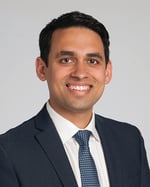INSIGHTS
A New Model for Sickle Cell Disease
By Ravi Talati, DO
One in 365 Black Americans is born with sickle cell disease. | Photos: Getty Images

Dr. Ravi Talati, a pediatric hematologist at Cleveland Clinic, is Co-Director of the Sickle Cell Disease Medical Neighborhood.
For decades, patients with sickle cell disease (SCD) have navigated a healthcare system that wasn’t built for them. Care was fragmented. Support was inconsistent. Many patients — most of whom are Black — were left to manage a complex, lifelong illness with limited resources and little trust in the institutions meant to help them.
At Cleveland Clinic, we knew we had to do better. That’s why we created the Sickle Cell Disease Medical Neighborhood.
This program is more than a care model. It’s a commitment. We designed it to replace reactive, piecemeal care with comprehensive, coordinated treatment that follows patients throughout their lives. Just like a neighborhood offers community and connection, our “medical neighborhood” surrounds patients with a dedicated team that knows them, cares for them and stays with them.
Our approach bridges emergency care, hospital stays, outpatient visits and specialty services. Whether a patient is seeing a hematologist, managing a pregnancy, recovering from a stroke or preparing for gene therapy, the medical neighborhood ensures everyone involved is working together — and working for the patient.
The results are powerful. Since launching in 2022, we’ve grown from 70 to more than 230 enrolled patients, ranging in age from infancy to their 70s. Hospitalizations are shorter, down from nine days to just over three on average. We’ve added social workers, care coordinators, psychologists and patient navigators who provide support far beyond the clinic walls. We’ve also launched an inpatient consultation service, bringing continuity and trust into the hospital setting.
These are not just process improvements. They are life-changing — and life-extending — outcomes.
Still, the need is great. Despite being more common than cystic fibrosis and hemophilia combined, SCD receives a fraction of the research funding and philanthropic support. That disparity has real consequences. Too many patients continue to fall through the cracks. Too many still rely on the ED as their primary source of care.
We’ve built something extraordinary. But we need help to expand it.
We’re seeking philanthropic partners to help us broaden access to outpatient infusion services, fund additional staff and data infrastructure, support mobile outreach, and offer home-based acute care. A dedicated community health worker is also needed to guide patients through complex care, connect them to vital resources and provide education and advocacy. Every investment strengthens our ability to scale this model and reach more patients, not just in Northeast Ohio, but nationally.
At Cleveland Clinic, we believe that equity isn’t an aspiration; it’s a responsibility. The Sickle Cell Disease Medical Neighborhood is one way we’re living that belief. Together, we can make sure every patient gets the care they deserve, when and where they need it most.
